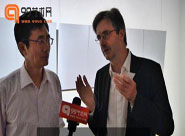.jpg)
Of Consciousness and Living
—Fu Yuxiang and His Paintings
Guan Yuda
Ever since archaeologists discovered the cliff paintings of animals such as wild oxen and horses in Lascaux in France and in Cave of Altamira near Santander in Spain, any history of western art has never lacked sculptures, architectures or paintings that take animals as subjects. Lascaux especially abounds with fables, fairy tales and allegories featuring animals. However, for audiences who are acquainted with Chinese contemporary art after 1990s, among such kind of works, it should be those by Fu Yuxiang, an artist living in Chongqing, that present the most fabled and pathetic temperament through images of animals, trees and people, since the 90s of the last century. In my point of view, Fu’s works, similarly as the British writer George Orwell’s Animal Farm, sincerely amplify man’s surviving dilemma in a manner of fable. The difference lies in that Orwell used a frostier and more ironic tone, metaphorized the myth of autocracy as the pattern of Soviet Russia into an “animal farm”, and spared no effort to satirize it; while Fu Yuxiang adopts a painting style that is warm and advisory, compares the unbalance of society nowadays to “living conditions of people and animals”, and maintains a compassion and mercy from Bodhisattva.
Fu Yuxiang himself is not an academic painter or a timeserver of the so-called “contemporary art”; his painting practice totally derives from his self-consciousness, and moreover from his daily cultivation according to the religious doctrines. As a believer of Tantric Buddhism, Fu regards painting as a day-to-day way of “realizing the truth” fulfilment and practising moral teachings, which enhances his works beyond the designation and crankiness of “substance” and “media” and keeps them away from the worldly ado and din, ascending to a spiritual level of seeing his true self. For Fu, painting is not only an exquisite bodily skill, but furthermore his own life. This stimulates associations in my mind with a story of from Tao Te Ching, within which it is just for fishing that the fishing rod exists, while have those who always carry a rod utterly forgotten what to use it for? Actually, art, indeed not a utilitarian activity, points to the aesthetic and play quality of life. Fu Yuxiang perceived this and tries to carry it out during his creating work, which is really a high jumping-off point and hard-won bourn. His painting practice has a common lot in artistic notions with Chinese traditional aesthetics, particularly the Zen branch of literati painting. And thus we feel quite familiar when appreciating his paintings.
In the lately twenty years, Chinese contemporary art practice has been congested with copied western modernism and postmodernism, which is resulted from that some artists put the cart before the horse, and simplify modernism into Occidentalism, hence completely murdering the self-confidence and reality of Chinese contemporary art, and transforming the Chinese renaissance and modernism into a farce where cultures of western colonization and post-colonization go upon the stage one by one. Fu Yuxiang’s praiseworthy quality lies in his composure among fashion; looking into the world calmly, he on the one hand pays close attention to the common issues like eco-crisis, and on the other hand, inducting wisdom into Chinese culture, especially the mercy of Buddhism, leads his unique way to broach the problem exoterically. In his paintings, the entanglement and even placement between animals and trees as well as animals and man, construct a scene of the last phase of age through symbolism and surrealism, within which we can both find the characteristics of western mediaeval and Renaissance paintings, such as Hieronymus Bosch and Pieter Bruegel with their admonishments about calamity and disease, and subtly the fancy of the terrestrial Pure Land and the disguised form of Hell from Buddhist tales. Fu Yuxiang’s works blend harmoniously Chinese and western elements, and from a stance of conscious man, he brings about doubts towards the world we are living in and the civilization we have been creating. The namely “all things you see are substantially nothing” and “everything that has a method to accomplish is just illusion” just tell us not to persevere in the superficial vision or deviate from humanity whatever you do. Fu regards painting itself as illusory appearance, and what matters for him is to pursue truth while painting, which is the true consciousness.
Fu Yuxiang only adopts black, white and grey but rarely other colours in his works. This sort of colouration is also similar to Chinese traditional brush drawing. Many critics have noticed this resemblance between them, but attribute this quality to the painter’s deliberateness. In fact, for Fu, since painting is a daily cultivation and sentimental practice, then it should be a sheer spiritual notion and ideology that painting refers to, yet not a material existence and demand. In this sense, Fu Yuxiang’s thinking has a similarity with the notional art of “Dadaism” and western modernism in their construction; in other words, the “notions” or “intentions” in Fu’s paintings mostly come from his opinion that “painting is a practice”. In Zen painting and calligraphy, forms such as colours and lines are just representations of a process in which the spiritual goal of “realizing truth” is achieved. After Bonze Hongyi retired from the world, he once firmly abnegated his favourite “artistic doings” of painting and calligraphy, while his bosom friend Xia Mianzun aroused him by saying “calligraphy can also deliver all living creatures from torment”. So we can see that from skill to cultivation, skill can never be abandoned. In Fu’s works, media representations including colouration all radiate a self-consciousness of “doing nothing is doing everything”, which naturally interlinks with Chinese traditional literati paintings, although the features his works wear are already provided with some modern tinges.
Fu Yuxiang’s paintings have some temperament of retiracy and reclusion. Even seen from his living style, his elusion from clamour and earthly life as well intercommunicates with his works. However, the painter himself does not advocate pessimism and aloofness; the other way round, he is an artist and religious believer with worldly concerns. American poet Ralph Waldo Emerson once said that “To go into solitude, a man needs to retire as much from his chamber as from society. I am not solitary whilst I read and write, though nobody is with me. But if a man would be alone, let him look at the stars. The rays that come from those heavenly worlds, will separate between him and what he touches” (Nature).
Now I remember the fathomless sky in Fu Yuxiang’s paintings. As a man of the same line, I hope that Fu will at times fix his gaze upon stars and sky, as well as persist in painting and thinking. Then, life and art should be leading towards truth, perfection and consciousness.
March 3-16, 2010
During journey between San Francisco, Chengdu and Kunming
【编辑:小红】

